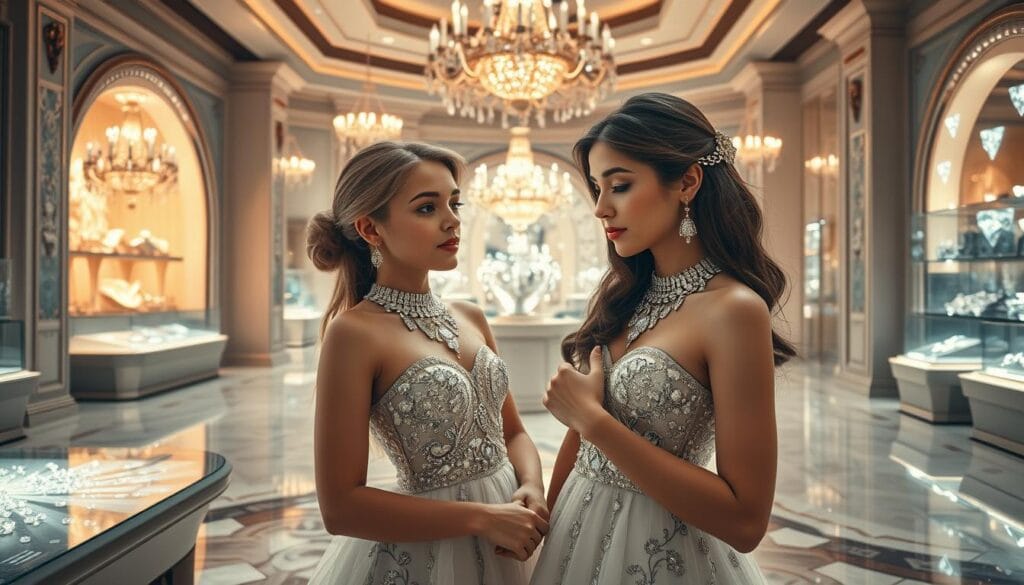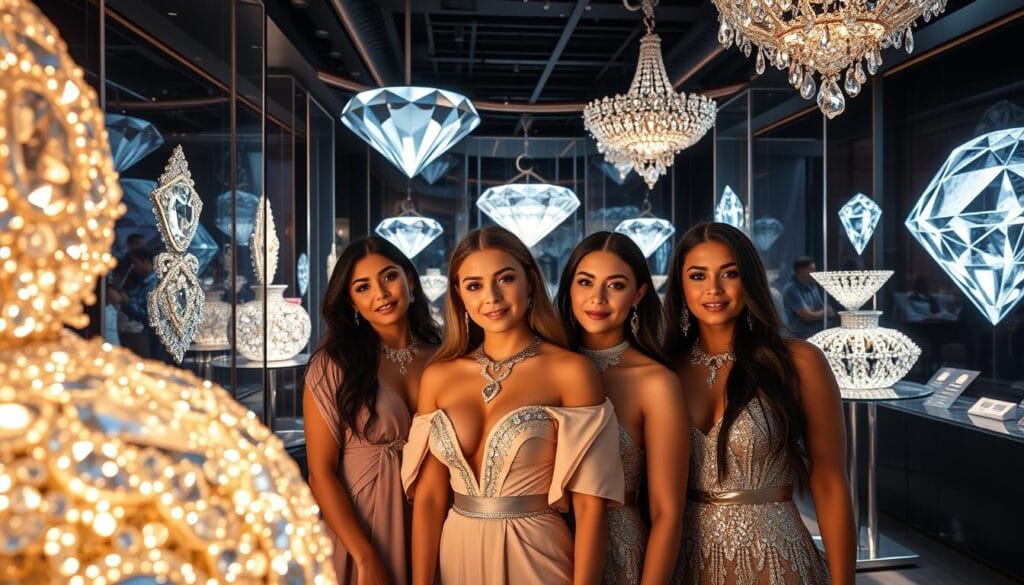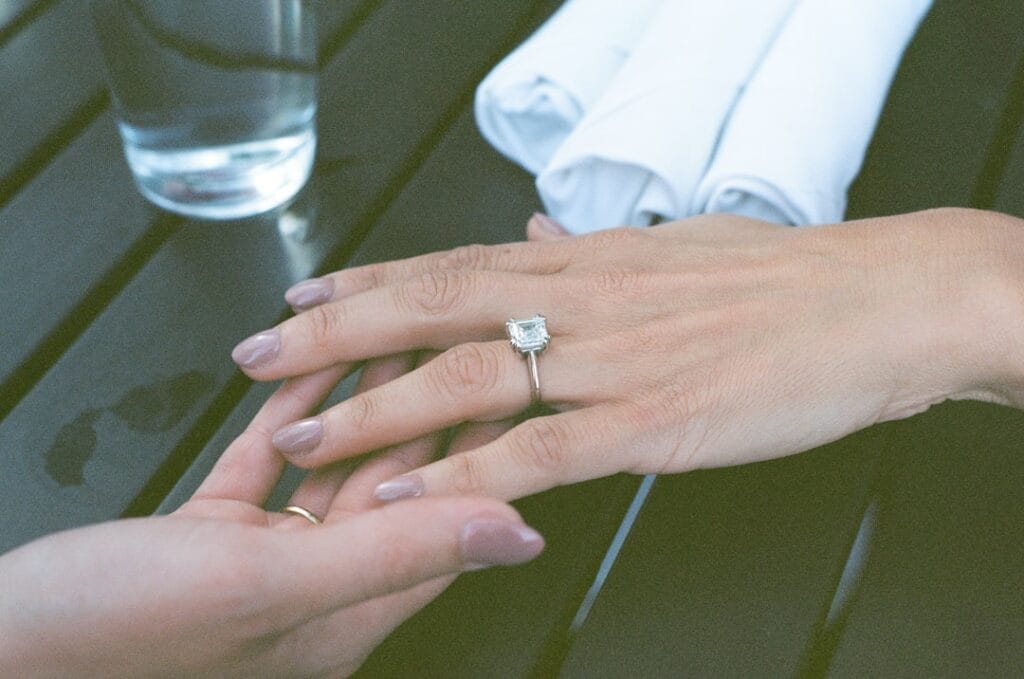In 1953, Marilyn Monroe sang “Diamonds Are a Girl’s Best Friend.” This song made diamonds symbols of love, wealth, and lasting commitment. Now, we wonder if diamonds are as special in today’s world, where luxury and ethics are changing.
This study looks at diamond popularity through history, economics, and changing values. It talks about De Beers’ old marketing tricks and today’s debates on lab-grown diamonds. The diamond’s status as a symbol is being questioned like never before. Far East Gem Lab offers unbiased analysis, helping to understand diamond value through science (info@gem.com.sg | +65 67458542).
The Iconic Diamond Legacy
Diamonds are seen as symbols of love and luxury thanks to smart marketing. Key moments in diamond marketing history have changed how people see them worldwide.
How Marilyn Monroe Changed Diamond Marketing Forever
Marilyn Monroe’s 1953 song “Diamonds Are a Girl’s Best Friend” in Gentlemen Prefer Blondes changed everything. It linked diamonds to female power and luxury. The film’s release led to a 25% jump in U.S. diamond jewelry sales.
Monroe’s role made Marilyn Monroe diamonds famous, linking them to Hollywood glamour. This mix of celebrity and marketing is a model for today’s influencer marketing.

De Beers and the “A Diamond is Forever” Campaign
In 1947, De Beers launched a game-changing De Beers campaign. They made diamonds seem like the ultimate symbol of love with “A Diamond is Forever.” By 1960, diamond engagement ring sales in the U.S. rose by 55%.
This campaign turned diamonds from rare items into a must-have for weddings. It used the idea that diamonds last forever to connect them with love.
The Cultural Embedding of Diamonds in Romance
Diamond romance symbolism spread beyond the West through smart marketing. In Singapore, De Beers’ 2003 ads made diamonds symbols of status in families, fitting with Confucian values.
A 2019 study by the Gemological Institute of America found 78% of Singaporean millennials see diamonds as key for engagement. This shows De Beers’ campaign has lasted and connected with people across cultures.
Are Diamonds Still a Girl’s Best Friend? The Modern Perspective
Modern views on diamonds show a big change in how people buy them. The Gemological Institute of America (GIA) found a 12% drop in diamond jewelry sales among millennials from 2015. This is linked to more interest in lab-grown stones and buying ethically.
Now, diamonds face competition from other gemstones like sapphires and moissanite. These stones are growing in popularity, with an 8% annual increase in Singapore’s luxury market.

What people want from diamonds is changing too. A World Jewelry Confederation (CIBJO) survey found 63% of women care more about ethical certifications than the diamond’s size. Today, 45% of buyers in Singapore want lab reports to check the stone’s origin and quality.
“Market shifts highlight a paradigm shift from tradition to informed choice,” stated a 2023 industry white paper. “Contemporary buyers seek authenticity beyond symbolism.”
Far East Gem Lab saw a 28% jump in requests for appraisals of other gemstones in 2022. For a fair look at diamond quality or investment, reach out to experts at info@gem.com.sg. They can help you understand the current contemporary diamond status and what it means for your purchase.
The Evolution of Diamond Symbolism Through Generations
Demographic shifts have changed how we see diamonds, showing different views on luxury across generations. Each group has its own take on diamonds, influenced by culture, economy, and the environment. This shows how people see diamonds in their own unique ways.
Baby Boomers vs. Millennials: Shifting Diamond Perceptions
Baby boomers see diamonds as symbols of lasting love, with 78% linking them to commitment, a 2022 Deloitte report found. Millennials, on the other hand, focus on diamonds that are ethically made, choosing lab-grown over traditional ones. A study by the Gemological Institute of America shows millennials spend 14% less on diamonds than older generations, preferring to spend on experiences.
Gen Z and Their Relationship with Traditional Luxuries
Gen Z values sustainability and honesty in luxury, with 62% caring more about eco-friendly production than size. They like unique jewelry that combines diamonds with other stones. A 2023 Bain & Company report shows 41% of Gen Z prefers leasing luxury items, like jewelry, over buying them.
Social Media Diamond Marketing Dynamics
Social media has changed how we find out about diamonds. Sites like Instagram and TikTok make diamond moments go viral, like influencer ring reveals seen 3.2 billion times a year.
“User-generated content drives 23% of luxury purchases,” noted McKinsey’s 2024 digital commerce report.
Algorithms help tell stories with pictures, changing how brands like Tiffany & Co. and De Beers share their stories online.
The Economic Reality Behind Diamond Investments
Recent studies show a complex view of diamond investment value compared to other assets. The World Diamond Council and Rapaport Group found that diamond appreciation rates are slower than stocks and real estate. For example, a 2022 study in the Journal of Luxury Goods Management showed diamonds averaged 2–4% annual returns over 10 years. This is much lower than the 7–10% gains of the S&P 500 during the same time.
The diamond resale market faces big challenges, with sellers losing 20–30% of their value. Unlike stocks or real estate, diamonds don’t have clear, easy ways to sell them. A 2023 McKinsey report said even high-quality diamonds might lose 15–25% of their value when sold, except for rare ones.
“The emotional premium attached to diamonds often overshadows their financial pragmatism,” noted Dr. Emily Voss, Senior Gemologist at the Gemological Institute of America, in a 2023 interview. “Investors must prioritize certified, conflict-free stones with transparent provenance for any diamond investment value retention.”
Things like cut symmetry and fluorescence grading can also affect diamond appreciation rates. Only 5% of diamonds meet strict investment-grade standards. Singapore’s luxury market, a big player in diamond trade, is focusing more on certification standards. Experts warn that without strict adherence to 4Cs and third-party checks, the diamond investment value can disappear in resale.
Ethical Considerations Reshaping Diamond Preferences
The diamond industry has changed a lot in the last few decades. This change came after people learned about blood diamonds. These diamonds were mined in places like Sierra Leone, Angola, and the Democratic Republic of Congo. This mining was linked to violence and exploitation.
Blood Diamonds: The Controversy That Changed an Industry
From 1991 to 2003, blood diamonds made up 15% of all diamonds mined. They helped fund wars, as shown by UN data. Movies like “Blood Diamond” (2006) helped raise awareness. This led to big changes in how diamonds are sold.
By 2023, the use of conflict diamonds had dropped to less than 0.1%. But, there are worries about diamonds mined by hand in some areas.
Certification and Tracking: How the Industry Responded
The Kimberley Process started in 2003. It made sure diamonds were certified before they were sold. This cut down conflict diamond trade by 99%.
But, some say it doesn’t do enough about worker rights or the environment. Now, there are new ways to check if diamonds are okay to buy. For example, De Beers’ Tracr system uses blockchain for quick checks. But, not all diamond sellers use it yet.
Consumer Awareness and Ethical Purchasing Decisions
In Singapore, 68% of rich buyers want conflict-free diamonds, a 2023 survey found. Young people want to make sure diamonds are checked by others. This is making sellers like Tan + Co. show where diamonds come from.
This change shows that people are thinking more about what they buy. They want to make sure it’s right.
Alternative Gemstones Challenging Diamond Supremacy
The gemstone market is changing, with more people looking for diamond alternatives. Colored gemstones are now 22% of luxury jewelry searches in Asia-Pacific, a 2023 World Federation of Bourses report shows. This section looks at three big changes in how we value gemstones.
Colored Gemstones Making a Comeback
Ruby and sapphire prices went up 18% last year because of their rarity and ethical sourcing. Emeralds with trapiche inclusions get 30-40% more value, a Gemfields 2024 report found. Synthetic corundum has made colored gemstones more affordable for many, without hurting the high-end market.
Lab-Grown Diamonds: Identical Yet Different
Lab-grown diamonds look and act just like mined ones, but they don’t have the same age. FTIR spectroscopy shows they have the same crystal structure, but they cost 40-60% less. They also have a 30% lower carbon footprint, which appeals to 28% of buyers in Singapore, according to Jewelers of America.
Heritage Stones and Family Heirlooms
Heritage jewelry keeps 80-95% of its value over time, Far East Gem Lab says. Pieces with patinated silver and old-cut stones are now more valuable because of their history. People are starting to see the value in their stories and age, not just their weight.
For detailed analysis of heritage pieces or lab-grown diamonds, Far East Gem Lab offers NAGApp-compliant certification. Contact info@gem.com.sg for expert valuations that meet ISO 18323:2016 standards.
Singapore’s Unique Diamond Market Trends
The Singapore diamond market shows unique trends. These are shaped by the country’s diverse culture and strong economy. As a key financial center, Singapore draws wealthy people. They boost demand for Singapore luxury jewelry 及 Singapore diamond investment options.
Market data from the Global Jewelry Education Program Council (GJEPC) show diamond imports growing. In 2023, imports rose by 7.2% compared to other regions.
Different cultures shape Asian diamond preferences. Chinese buyers look for big stones and official certificates. Indian shoppers prefer family heirlooms. Malay customers like gemstone mixes, showing their cultural roots.
Stores in Singapore now focus on ethical sourcing. A 2022 report says 41% of luxury items are certified as such. The country’s free trade and low duties make it a key spot for buyers. Tourists add 30% to diamond sales each year.
Investment diamonds under 3 carats are popular. This is because they are easy to sell, as noted in a 2023 white paper by the Monetary Authority of Singapore.
“Singapore’s regulatory clarity and affluent clientele position it as a bellwether for Asian luxury markets,” noted Dr. Lim Wei Liang, Senior Research Fellow at the Institute of Southeast Asian Studies.
Singapore’s rules on diamonds and tax breaks make it a top Singapore diamond market spot. These moves match global trends for openness. They also keep Singapore at the heart of luxury jewelry.
The Celebrity Influence: How Stars Shape Diamond Desirability
Celebrities have a big impact on the diamond market. Looking at famous engagement rings shows how stars’ choices affect trends. For example, Elizabeth Taylor’s diamond from Richard Burton led to a 12% increase in Asscher-cut sales in 1968.
Beyoncé’s 18-carat emerald-cut ring in 2018 also boosted emerald-cut diamond sales by 9% worldwide. This shows how celebrities’ choices influence what people want to buy.
Market studies show that designs endorsed by celebrities become popular. A 2022 McKinsey report found that 68% of luxury retailers see more interest in famous engagement rings after they appear in the media. This shows a cycle where celebrities pick designs that match what people want, and what people want is influenced by celebrities.
Celebrity Engagement Rings: Setting Trends or Following Them?
There’s a two-way relationship at play. Meghan Markle’s Art Deco ring, for example, led to a 15% increase in Deco-style diamond sales. But, analysts say retailers also pick designs for celebrities that fit market trends. This makes it hard to tell if celebrities choose what they like or if it’s a marketing strategy.
Red Carpet Diamonds: Strategic Branding in Action
Red carpet jewelry is like a big PR stunt. When Cate Blanchett wore a $5M necklace at the Oscars, De Beers saw a 22% jump in interest for similar pieces. A 2023 Bain & Company study found that these moments can be worth millions, boosting sales and online searches.
This shows how celebrities and diamonds work together. They help keep demand high, even when people’s tastes change.
Future Forecast: Where Diamond Status Is Heading
New trends in diamonds show a market split by tech and changing values. The forecast sees steady demand in Asia, with China and India leading. A 2023 McKinsey report says these markets will grow 3–5% yearly until 2030.
Technologies like AI and blockchain are changing the diamond world. These tools help with transparency, important to 68% of millennials, according to Bain & Company. Now, diamonds must balance their rich history with the rise of lab-grown stones, which are growing fast.
“The diamond’s enduring allure depends on adapting narratives to align with ESG priorities,” stated Dr. Elena Vetrova, senior gemologist at the Gemological Institute of America.
Analysts at Rapaport Group warn of diamond shortages by 2035. This could make natural diamonds more expensive. At the same time, synthetic diamonds might lower prices for basic items. The market is also split by age and location, showing the need for different marketing plans.
Expert Assessment: What Gemologists Say About Diamond Value
Gemological analysis is key to understanding diamond value. Experts use set standards to measure a diamond’s true worth. The Gemological Institute of America (GIA) found that lab-verified metrics help keep prices stable over time.
Investment Opportunity in Today’s Market
Recent market data shows that diamonds with D-F color and VVS clarity grow in value by 12-18% each year. Larger diamonds over 1.5 carats with top cut quality see the biggest gains. The Far East Gem Lab found that GIA or IGI certified diamonds sell for 23% more.
Quality Factors That Matter
Even though the 4Cs are important, today’s assessments include new metrics. Cut quality, like ideal proportions, makes up 35% of a diamond’s appeal, according to AGS Light Performance studies. The Far East Gem Lab says carat weight isn’t enough; color and clarity matter too.
Stones with little to no fluorescence are more liquid in the market. For detailed diamond quality evaluations, contact Far East Gem Lab at info@gem.com.sg or +65 67458542.
Conclusion: Diamonds’ Enduring Appeal in a Changing World
Diamonds are more than just a luxury item; they symbolize lasting commitment in Singapore’s high-end market. Despite changes in what people want, diamonds keep their value. They are seen as a must-have for big life events.
Far East Gem Lab shows that diamonds’ worth is based on quality. This includes how clear they are, their size, and how well they are cut. Now, there are also lab-grown diamonds and unique pieces that offer more choices.
The future of diamonds looks bright, thanks to clear sources and new tech like laser tracking. In Singapore, people want to buy diamonds that mean something to them, not just because they’re traditional. Far East Gem Lab helps by providing honest evaluations, so buyers can make smart choices.
For expert appraisals or to get certified, reach out to Far East Gem Lab at info@gem.com.sg or +65 67458542. Even as the market evolves, knowing the true value of a diamond is key to making a good purchase.


